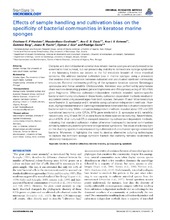| dc.description.abstract | Complex and distinct bacterial communities inhabit marine sponges and are believed to be essential to host survival, but our present-day inability to domesticate sponge symbionts in the laboratory hinders our access to the full metabolic breadth of these microbial consortia. We address bacterial cultivation bias in marine sponges using a procedure that enables direct comparison between cultivated and uncultivated symbiont community structures. Bacterial community profiling of the sympatric keratose species Sarcotragus spinosulus and Ircinia variabilis (Dictyoceratida, Irciniidae) was performed by polymerase chain reaction-denaturing gradient gel electrophoresis and 454-pyrosequecing of 16S rRNA gene fragments. Whereas cultivation-independent methods revealed species-specific bacterial community structures in these hosts, cultivation-dependent methods resulted in equivalent community assemblages from both species. Between 15 and 18 bacterial phyla were found in S. spinosulus and I. variabilis using cultivation-independent methods. However, Alphaproteobacteria and Gammaproteobacteria dominated the cultivation-dependent bacterial community. While cultivation-independent methods revealed about 200 and 220 operational taxonomic units (OTUs, 97% gene similarity) in S. spinosulus and I. variabilis, respectively, only 33 and 39 OTUs were found in these species via culturing. Nevertheless, around 50% of all cultured OTUs escaped detection by cultivation-independent methods, indicating that standard cultivation makes otherwise host-specific bacterial communities similar by selectively enriching for rarer and generalist symbionts. This study sheds new light on the diversity spectrum encompassed by cultivated and uncultivated sponge-associated bacteria. Moreover, it highlights the need to develop alternative culturing technologies to capture the dominant sponge symbiont fraction that currently remains recalcitrant to laboratory manipulation. | en_US |

